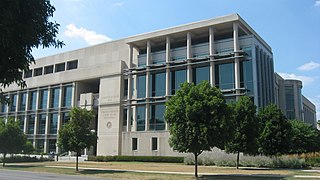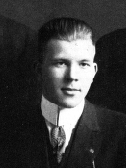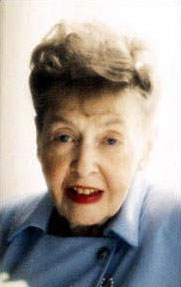
Indiana University Bloomington is a public research university in Bloomington, Indiana. It is the flagship campus of Indiana University and its largest campus with over 40,000 students. Established as the state's seminary in 1820, the name was changed to "Indiana College" in 1829 and to "Indiana University" in 1838.

Indiana University–Purdue University Indianapolis, commonly referred to as IUPUI, is a public research university in Indianapolis, Indiana, United States. It is a collaboration between Indiana University and Purdue University that offers undergraduate, graduate, and professional degrees from both universities. Administered primarily through Indiana University as a core campus and secondarily through Purdue University as a regional campus, it is Indiana's primary urban research and academic health sciences institution. IUPUI is located in downtown Indianapolis along the White River and Fall Creek.

The Indiana University School of Medicine (IUSM) is a major, multi-campus medical school located throughout the U.S. state of Indiana and is the graduate medical school of Indiana University. There are nine campuses throughout the state; the principal research, educational, and medical center is located on the Indiana University–Purdue University Indianapolis (IUPUI) campus in Indianapolis. With 1,452 MD students, 203 PhD students, and 1,356 residents and fellows in the 2022–23 academic year, IUSM is the largest medical school in the United States. The school offers many joint degree programs including an MD/PhD Medical Scientist Training Program. It has partnerships with Purdue University's Weldon School of Biomedical Engineering, other Indiana University system schools, and various in-state external institutions. It is the medical school with the largest number of graduates licensed in the United States per a 2018 Federation of State Medical Boards survey with 11,828 licensed physicians.

The Indiana University Robert H. McKinney School of Law is located on the campus of Indiana University – Purdue University Indianapolis (IUPUI) in Indianapolis, Indiana, the urban campus of Indiana University. In the summer of 2001, the school moved to its new building, Lawrence W. Inlow Hall. IU McKinney is one of two law schools operated by Indiana University, the other being the Indiana University Maurer School of Law in Bloomington. Although both law schools are part of Indiana University, each law school is wholly independent of the other. According to IU McKinney's 2019 ABA-required disclosures, 59% of the Class of 2018 obtained full-time, long-term, J.D.-required employment within ten months after graduation.

Indiana University—Purdue University Columbus (IUPUC) is a public university in Columbus, Indiana, United States. IUPUC offers degree programs from both Indiana University and Purdue University.

Josiah Kirby "Joe" Lilly Jr. was a businessman and industrialist who served as president and chairman of the board (1953–66) of Eli Lilly and Company, the pharmaceutical firm his grandfather, Colonel Eli Lilly, founded in Indianapolis in 1876. Lilly, the younger son and namesake of Josiah K. Lilly Sr., graduated from the University of Michigan's School of Pharmacy in 1914 where he was a member of the Chi Psi Fraternity. He served in the U.S. Army in France during World War I. At Eli Lilly and Company, where his primary focus was marketing and human resources, he served as vice president of marketing, executive vice president of the company, and president of Eli Lilly International Corporation, before succeeded his older brother, Eli Jr., as company president in 1948 and as chairman of the board in 1953.

Ruth Lilly was an American philanthropist, the last surviving great-grandchild of Eli Lilly, founder of the Eli Lilly and Company pharmaceutical firm, and heir to the Lilly family fortune. A lifelong resident of Indianapolis, Indiana, Ruth Lilly is estimated to have given away nearly $800 million of her inheritance during her lifetime, mostly in support of the arts, education, health, and environmental causes in Indianapolis and in Indiana.

IUPUI University Library is the university library of Indiana University–Purdue University Indianapolis. IUPUI is an urban campus of Indiana University and Purdue University in Indianapolis, Indiana, United States. Indiana University is the managing partner.
The Luddy School of Informatics, Computing, and Engineering is an academic unit of Indiana University located on the Indiana University Bloomington (IUB) campus and on the Indiana University – Purdue University Indianapolis (IUPUI) campus. On the Bloomington campus, the School consists of the Department of Informatics, the Department of Computer Science, the Department of Information and Library Science, and the Department of Intelligent Systems Engineering. On the Indianapolis campus, the School consist of the Department of Human-Centered Computing, the Department of BioHealth Informatics, and the Department of Library and Information Science.
William Marmaduke Plater is an American higher education consultant and Indiana University Chancellor's Professor Emeritus of Public Affairs, Philanthropy, and English, and Executive Vice Chancellor and Dean of the Faculties Emeritus at Indiana University-Purdue University Indianapolis (IUPUI).
The Indiana University School of Nursing is an academic college of higher education connected to Indiana University with its main research and educational facilities on the Indiana University – Purdue University Indianapolis campus and at Indiana University Bloomington. It is known for its nursing research and education, scholarship of teaching and nursing practice, and for its collaborations with IU hospitals and clinical partners. Established in 1914 as the Indiana University Training School for Nurses, it awarded its first nursing diplomas in 1917 and was renamed the IU School of Nursing in 1956. It offers a four-year Bachelor of Science in Nursing (BSN) degree, a Master of Science in Nursing (MSN) degree, and two doctoral degrees: Doctor of Nursing Practice (DNP) and Doctor of Philosophy (Ph.D.). The IU nursing school has received multiple research grants from the National Institutes of Health.

Maynard K. Hine Hall and University Tower is a conjoined academic center and first-year student residence located on the Indiana University Indianapolis campus. The building is located north of Robert E. Cavanaugh Hall, Joseph T. Taylor Hall, and the Business/SPEA Building. The building serves as a hub of student activity with its close proximity to the IUPUI Campus Center to the southwest, Lockfield Green to its north, and the North Residence Hall to its northwest.

Sidney & Lois Eskenazi Hall is home to the Indiana University Herron School of Art and is located on the south side of the Indiana University Indianapolis campus. To its north lies the Wood Plaza and University Library, to the east is Military Park, and to its West is the Indiana University Natatorium. The academic building contains three public art galleries for Indianapolis artists and students to display various pieces and exhibits, and a large art library containing a huge collection of literature on art, architecture, design, and creative technologies.
University Hall is located at the corner of New York Street and University Boulevard and is home to the IUPUI Administration, IU Foundation, Lilly Family School of Philanthropy, and the IU School of Social Work. The building is located south of the Indiana University Indianapolis Lecture Hall and to the west of the Education and Social Work Building.

Emerson Hall was the first building constructed on the IU Medical Center campus as part of the Indiana University School of Medicine. The construction of the building marked the beginning of the presence of IU in Indianapolis and the growth of Indiana medical education. The building is located in between the University Hospital Cancer Pavilion to its south and the Van Nuys Medical Science Building to its north, and across from Willis D. Gatch Hall to its west.

Fesler Hall is located on the western end of Indiana University Indianapolis campus as part of the IU Medical Center. The building was the former site of the Indiana State Board of Health headquarters until being occupied by Indiana University in 1949. During the board of health's occupation, the building served as a hub for public health outreach and education programs in cooperation with the Indiana University School of Medicine. Indiana University used the building as a new center for clinical programs located on the campus to compensate the growing medical student population. Fesler Hall is located in a cluster of medical facilities that include the Eugene and Marilyn Glick Eye Institute, William H. Coleman Hall, Robert W. Long Hall, Willis D. Gatch Hall, and the School of Nursing Building.

Robert E. Cavanaugh Hall was one of the first non-medical academic buildings constructed on the IUPUI campus alongside Joseph T. Taylor Hall, known as the Blake Street Library at that time, and the Lecture Hall. Cavanaugh Hall served as an early hub for academic, administrative, and student activities which would lead to a constantly reshuffling of space usage. Competition of space for classrooms, administrative activities, and student activities would underscore the history of Cavanaugh Hall. Cavanaugh Hall currently serves as the home for the IUPUI School of Liberal Arts and various related research units.
Willis D. Gatch Hall, shortened to Gatch Hall, was constructed as an addition for the former Robert W. Long Hospital. Gatch Hal served as additional space for outpatient services, clinical services, and imaging services. Following the construction of University Hospital and the reorganization of medical services on the IU Medical Center, Gatch Hall would transition to an academic center supporting the School of Allied Health, Division of Nuclear Medicine, and Department of Radiology. The building continues to serve as an academic center for various divisions and departments within the IU School of Medicine. Gatch Hall was one of the early buildings on the IU Medical Center alongside Fesler Hall, Emerson Hall, and Coleman Hall. The Eugene and Marilyn Glick Eye Institute and the School of Nursing Building are more recent additions to the IU Medical Center cluster.
The Van Nuys Medical Science Building is located on the IUPUI Campus as part of the IU Medical Center. The building serves as an academic and research facility for the IU School of Medicine providing significant laboratory space for the campus. Originally, the building served to consolidate academic laboratory functions on the campus into a singular facility and provide space for the creation of a more robust medical library. Upon completion, the building provided new research space for Robert W. Long Hall, William H. Coleman Hall, Fesler Hall, Willis D. Gatch Hall, and Emerson Hall. The building is located just north of Emerson Hall and University Hospital, and adjacent to the Medical Research and Library Building.
The Institute of Psychiatric Research (IPR) was a four-story freestanding medical research building dedicated to studying neurological and psychiatric disorders. The building worked closely with other researchers and faculty at the IU Medical Center on the IUPUI campus and the Larue D. Carter Psychiatric Hospital. IPR is now located at the Indiana University Neuroscience Research Building alongside the Starke Neurosciences Research Institute on the Academic Health Campus next to IU Health Methodist Hospital.













